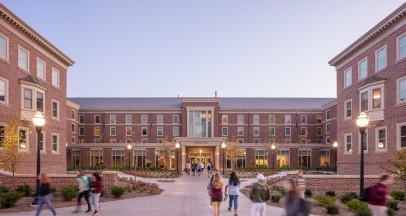The $104.5 million renovation and expansion of historic Pioneer Hall at the University of Minnesota was honored March 6 with its second design award of the year – this time by the Precast/Prestressed Concrete Institute (PCI). The project also received a Grand Award in January from the American Council of Engineering Companies of Minnesota (ACEC/MN).
The 57th annual PCI Design Awards showcase the creative and innovative use of precast and prestressed concrete in a variety of applications. A panel of industry experts that includes precast concrete producers, engineers and architects judged the nominees. The buildings and transportation categories were judged on aesthetic, structural and use versatility; site, energy and operational efficiency; risk reduction; and resiliency, such as structure durability, multi-hazard protection, and life safety and health.
Pioneer Hall won in the Higher Education/University building category. Wells Concrete of Albany, MN provided the precast concrete on the project. KWK Architects led the design effort on the project, partnered with architecture/engineering firm-of-record TKDA of St. Paul, MN.
KWK Principal Sara Koester said specifying precast concrete panels on the Pioneer Hall project design was the right choice, for a variety of reasons.
“Precast insulated concrete panels are an excellent exterior wall system. Precast insulated panels helped to achieve the energy goals and exterior wall thermal performance that we wanted on the project, while being very cost effective,” said Koester. “The exterior expression that we were able to achieve through use of the precast concrete panels complemented the existing historic building character. The precast concrete panels also offered us the ability to design with precast trim to animate the exterior at an affordable cost and they enabled the building’s exterior skin to be completed and enclosed quickly, which was very important on the project’s tight schedule.”
The newly renovated and expanded 90-year-old Pioneer Hall opened for the fall 2019 semester. The project increased the number of student beds at the residence hall from 693 on four floors to 756 on five floors, while preserving a significant amount of the structure’s historic Georgian Revival-style exterior. The renovation also increased the hall’s total square footage from 177,000 SF to 257,000 SF, with demolition of the existing building limited to the center construction and within the courtyards, with approximately 60% of the typical upper floors being retained.
A new 42,000 SF dining facility was also built with seating for 850 students that features eight venues arranged in a Main Street configuration. A new central, sub-basement level was built to accommodate new mechanical, electrical, and telecom rooms.
The renovated residence hall features accessible, community-style living unit modules with a small group of residents sharing a community bathroom. These facilities are grouped with single-use private bathrooms to offer varying levels of privacy. Studies and lounges are provided for the communities, and a dedicated floor lounge allows for larger gatherings. Classroom, multipurpose, music practice, recreation rooms, large student kitchen, meditation and tech/business center provide a variety of spaces for students to gather, study or relax.
Previous Article: KWK Architects Hires Architectural Associate Heather Grove
Next Article: Residence Hall Design Trends to Change in Response to COVID-19





